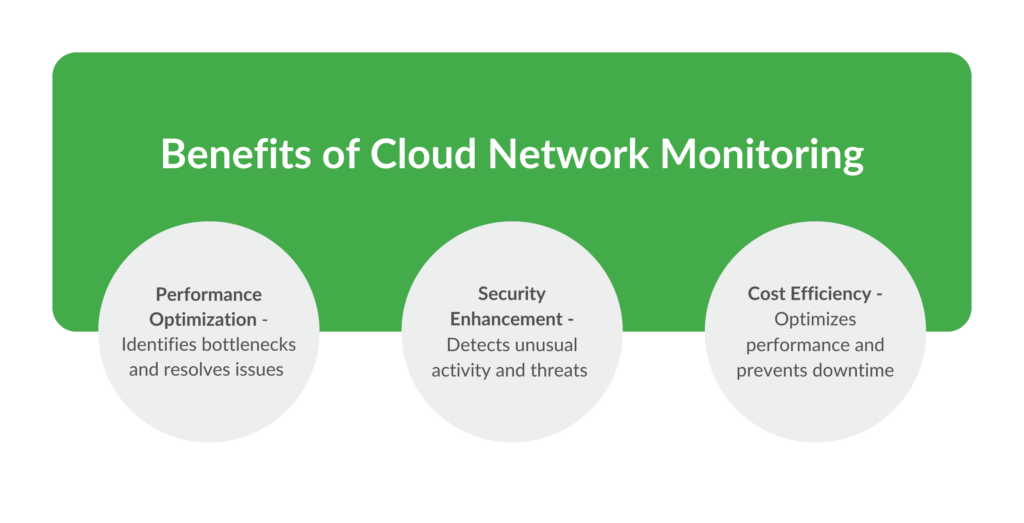Cloud Network Monitoring – What is it and Why is it Important?

Introduction
In the modern business landscape, cloud computing has become a cornerstone of IT infrastructure. Organizations are increasingly relying on cloud-based solutions to store data, run applications, and manage critical operations. With this shift, ensuring that these cloud networks run smoothly and securely has never been more important. This is where cloud network monitoring comes into play.
Definition: What is Cloud Network Monitoring?
Cloud network monitoring refers to the process of continuously observing and managing the performance and security of cloud-based networks. Simply put, it’s like having a dedicated team of digital “watchdogs” that keep an eye on your cloud infrastructure, ensuring everything functions as it should.
Importance:
In today’s fast-paced business environment, the smooth operation of cloud networks is crucial. Any downtime or performance issues can lead to significant disruptions, impacting productivity and customer satisfaction. Effective cloud network monitoring helps businesses maintain operational efficiency, prevent potential issues, and secure their cloud environments.
Understanding Cloud Network Monitoring
Difference Between Traditional Network Monitoring and Cloud Network Monitoring
Traditional network monitoring typically focuses on on-premises hardware and software, using tools that monitor network traffic and performance within a physical data center. In contrast, cloud network monitoring deals with dynamic and distributed environments where resources and services are spread across multiple locations and managed by third-party providers.
How Cloud Network Monitoring Works
Overview of the Monitoring Process:
Cloud network monitoring involves several key steps: data collection, performance analysis, and issue identification. First, monitoring tools gather data from various cloud components, such as servers, applications, and network connections. This data is then analyzed to assess performance metrics like bandwidth usage, latency, and packet loss. If any issues or anomalies are detected, alerts are generated for prompt resolution.
Types of Data Monitored:
Commonly monitored data includes bandwidth usage (how much data is being transferred), latency (the delay in data transfer), and packet loss (data that doesn’t reach its destination). These metrics help in understanding the efficiency and reliability of cloud services.
Common Tools and Technologies:
Several tools and technologies facilitate cloud network monitoring, including platforms like Auvik and Azure Monitor. These tools provide real-time insights, performance analytics, and automated alerts to ensure optimal network operation.
Benefits of Cloud Network Monitoring
Performance Optimization
How Monitoring Helps in Optimizing Network Performance:
Monitoring tools help identify bottlenecks and inefficiencies in network performance, allowing businesses to address issues before they impact users. For instance, if latency is high, adjustments can be made to improve speed and responsiveness.
Examples of Performance Metrics:
Key performance metrics that can be improved through monitoring include reduced latency (faster response times), increased bandwidth (more data transferred), and minimized packet loss (reduced data errors).
Security Enhancement
Role of Monitoring in Detecting and Preventing Security Threats:
Cloud network monitoring plays a crucial role in security by detecting unusual activity and potential threats. For example, monitoring can identify unauthorized access attempts or unusual data transfers, enabling swift action to prevent breaches.
Common Security Issues Identified Through Monitoring:
Typical security concerns that can be flagged by monitoring include potential data breaches, unauthorized access, and malicious activity. Early detection helps in mitigating risks and maintaining a secure cloud environment.
Cost Efficiency
How Cloud Monitoring Can Lead to Cost Savings:
By optimizing network performance and preventing downtime, cloud network monitoring contributes to cost savings. Efficient resource usage and reduced incidents of network failures can lower operational costs and improve overall profitability.
Examples of Cost-Related Benefits:
Cost benefits include reduced downtime (which minimizes lost revenue) and better resource allocation (ensuring that cloud resources are used efficiently and economically).
Challenges of Cloud Network Monitoring
Complexity
Discussing Complexity in Multi-Cloud and Hybrid Cloud Environments:
Monitoring networks in multi-cloud and hybrid environments can be complex due to the diversity of cloud services and providers. Coordinating monitoring efforts across different platforms and ensuring consistency can be challenging.
Data Overload
Handling Large Volumes of Monitoring Data:
Cloud monitoring generates vast amounts of data, which can be overwhelming. Effective data management and analysis tools are essential to filter out noise and focus on actionable insights.
Integration with Existing Systems
Challenges in Integrating Cloud Monitoring with Existing On-Premises Solutions:
Integrating cloud network monitoring with traditional on-premises monitoring systems can be difficult. It requires compatibility and seamless data flow between different monitoring tools and platforms.

Why Cloud Network Monitoring is Important for Businesses
Ensuring Business Continuity
Importance of Uptime and Reliability:
Maintaining high uptime and reliability is critical for business continuity. Cloud network monitoring supports this by detecting and addressing issues before they lead to significant disruptions, ensuring that services remain available and reliable.
Enhancing Customer Experience
Maintaining High Service Quality:
Monitoring helps ensure that cloud-based services meet performance expectations, leading to a better customer experience. For instance, a well-monitored network can ensure that online services remain responsive and available.
Examples of Better Customer Satisfaction:
Monitoring can help maintain website speed and application responsiveness, which directly contributes to higher customer satisfaction and retention.
Compliance and Regulatory Requirements
Helping Businesses Stay Compliant:
Many industries have regulations that require continuous monitoring of IT systems to ensure compliance. Cloud network monitoring helps businesses adhere to these regulations by providing necessary oversight and reporting.
Examples of Regulations:
Regulations like GDPR (General Data Protection Regulation) and HIPAA (Health Insurance Portability and Accountability Act) may mandate regular monitoring to ensure data protection and privacy.
Choosing the Right Cloud Network Monitoring Solution
Key Features to Look For
Essential Features:
When selecting a cloud network monitoring solution, look for features such as real-time monitoring, scalability, and effective alerting capabilities. These features ensure that the monitoring solution can adapt to your needs and provide timely insights.
Customization and Flexibility
Importance of Adaptability:
A solution that can be customized to fit specific business needs is crucial. Flexibility in monitoring settings and reporting helps tailor the solution to the unique requirements of your organization.
Vendor Comparison
Brief Comparison:
Popular cloud network monitoring tools include Auvik and Azure Monitor. Each offers different features and capabilities, so it’s important to compare these tools based on your specific needs and preferences.
Conclusion
Cloud network monitoring is essential for maintaining the performance, security, and cost-efficiency of your cloud-based infrastructure. By investing in a robust monitoring solution, businesses can protect their infrastructure, optimize performance, and enhance security. If you’re ready to improve your cloud network monitoring or need guidance on choosing the right solution, contact us for a consultation or to learn more about our offerings.
Explore more on:





